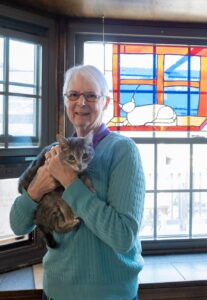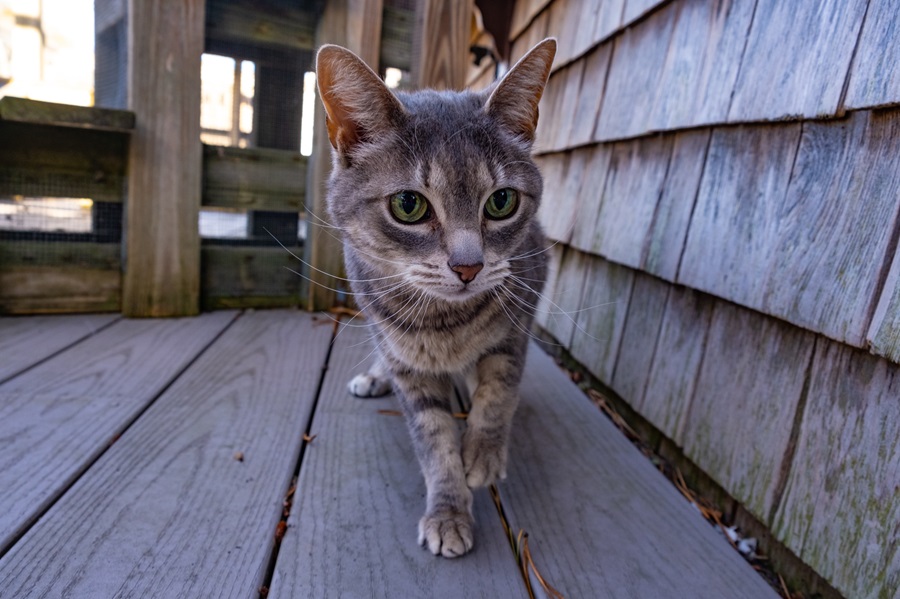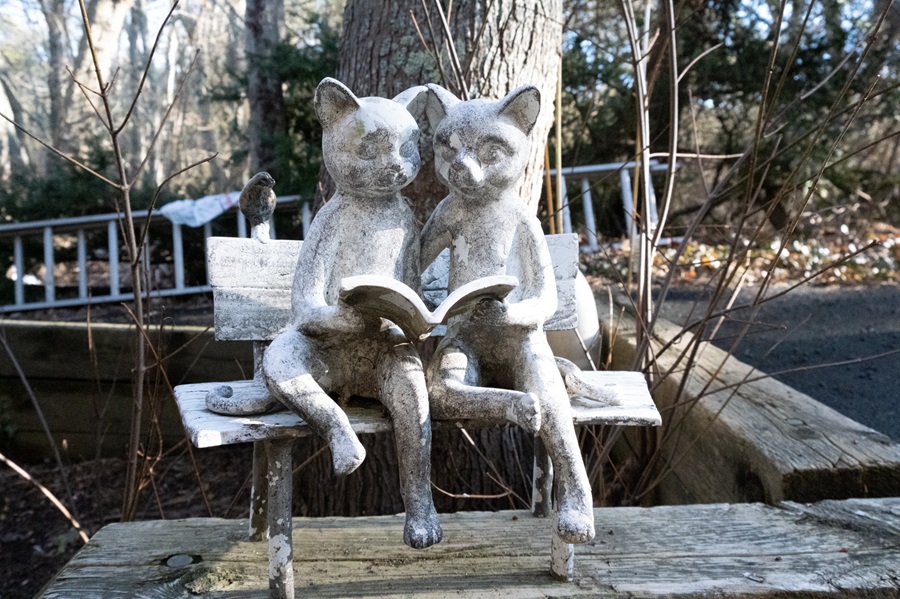Cat statuary flanks the fireplace of the house at 5 Sandy Hill Lane in Provincetown. On one side, a stone angel cradles a kitten on its lap. On the other side stands a tall wooden cat, painted black and white, with a blush-pink muzzle and bright turquoise eyes under arching eyebrows. Dave Butler, the treasurer of CASAS, the Carrie A. Seaman Animal Shelter, calls that cat a “guardian” of the cats that occupy the house.
Here, felines are featured in pictures and paintings and prints on every wall: there’s the George Booth New Yorker cover from Jan. 5, 1981, in which dozens of cats have a New Year’s Eve party in an apartment where they clearly rule. There’s also a row of Pop-Art watercolor cats from the 1954 book 25 Cats Name Sam and One Blue Pussy, illustrated by a young Andy Warhol and featuring his mother Julia Warhola’s calligraphy.
In a place of honor at the top of the staircase, there is an oval portrait of Carrie Seaman. Born in 1905, Seaman was a lawyer in Boston for two decades before she and her husband, Joseph, purchased the Town Crier Shop at 265 Commercial St. in 1951. They ran it until 1966.

Seaman also owned a house at 361 Commercial St., where she was the landlady who famously called the police on Divine, according to David W. Dunlap in Building Provincetown. Dunlap cites John Waters describing the event to Gerald Peary in an interview for Provincetown Arts in 1997. The story goes that when Seamen was away one weekend, Divine auctioned off the antiques in the apartment to cover his rent.
Apart from Seaman’s career in law and landladyship, “She was also a cat lady,” says Anita Butler, the co-vice president of the CASAS board and Dave’s wife. Seaman founded the Provincetown Animal Shelter in 1971 at 334 Commercial St. When she died at 84 in 1989, says Anita, she left money for a new shelter to be built in town. That didn’t happen, but in 2007, the zoning board of appeals granted a special permit to allow the operation of an animal shelter in the house on Sandy Hill Lane.
Because it’s in a residential neighborhood, CASAS now shelters only adoptable cats, not dogs — they were deemed too loud. Some of the cats the organization shelters are strays, but many previously had homes and now need new ones, according to board president Sherry Brec.
Brec says the nonprofit handles about 50 adoptions a year. After seeing through 23 adoptions in the last six months, she says, only four “forever cats” are in residence right now — older cats who need special attention.
Jackie Gilmore, a volunteer from Truro, holds Dixie, a gray tabby with large green eyes, against her chest. Dixie’s soft paws knead Gilmore’s neck. The cat was declawed by her previous owners, says Anita. Declawing is the amputation of the last bone of each toe on a cat’s paw. According to the Humane Society of the United States, which opposes the practice, it increases the odds of chronic pain in cats, and can cause behavioral issues, as it makes it impossible for cats to scratch — their natural method of defense. The practice is prohibited in New York and Maryland and became illegal in Massachusetts in January this year.

A large orange cat named Tyler Perry, nearly hidden on the lowest level of a cat tree in the corner, had glaucoma in one of his eyes. He had to have the eye removed. Tyler will swat away a strange hand, says Anita, “but he’ll come out for me.” He’s had a hard life, she says. “He can do whatever he wants.”
Another elder, Sonia, basks in the sunlight streaming through a window in the next room. She was adopted from CASAS as a kitten, but 10 years later her family moved and couldn’t take her. “We will always take our kitties back,” says Anita. “People generally don’t want older cats. Here, she has a good life.”
Ollie, the fourth cat, who is “kind of crabby,” gazes out the windows hopefully, though there aren’t any birds in view today.

There are times when the house is full of younger cats. Last year, says Brec, whose sweatshirt reads “Mother of Cats,” a litter of eight kittens was born at the shelter. The litter’s mother, Honey, was a stray that had probably been in a home at some point, Brec says.
Nine volunteers staff CASAS. That means opening the house to visitors daily from 2 to 3:30 p.m., cleaning litter boxes, organizing supplies, and sweeping the floors — but mostly their job is to socialize with the cats.
CASAS also intervenes to help prevent the need for adoption. They see many cases, Brec says, where aging people who are struggling financially don’t have the money for their pets’ food or medicine. “We try our best to keep the animals in their homes,” says Brec.
Before Brec became a volunteer at CASAS, she worked as a clinical coordinator in pediatric radiology at Massachusetts General Hospital. “I worked with kids,” says Brec. “Now I work with cats. It’s very similar. Kids can’t tell you what’s wrong all the time. You’ve got to be very visual, hands on, and figure it out.”

The shelter used to have an in-house volunteer veterinarian, Dr. Michael McDonnell. Working from a small, bright exam room in the back of the second floor, he performed spaying and neutering procedures, dental work, and eye surgeries. Now “Dr. Mike” is retired, though he still has his license, says Anita, and when he comes to Provincetown he vaccinates the cats. For everything else, CASAS turns to Dr. Sadie Hutchings in Provincetown or Dr. John Kelley in Wellfleet.
To provide its services, CASAS relies on donations. In September, they organize Pet Appreciation Week in Provincetown, which includes the Blessing of the Animals, the Pet Parade, and Pet Tea. A pizza party at Montano’s on Thursday, March 13 is also a fundraiser.
CASAS is “no-cage, no-kill,” says Anita. The cats don’t live in cages unless it’s medically necessary. In each room there’s at least one cat tree or climbing structure, and the house’s large windows are ideal for bird watching. “Yesterday there were hundreds of robins out there,” says Anita.
In addition to their rooms, there are “catios” — cat patios — screened-in outdoor areas on the second-floor deck. These spaces allow the cats to be outside in a safe way, says Anita. “They’re out in the fresh air; they have things to think about,” she says. “They’re happier cats.”
“We often say that we’d like to come back in our next life as a CASAS cat,” says Anita. “I don’t know if we’re crazy, but we certainly are cat people.”



